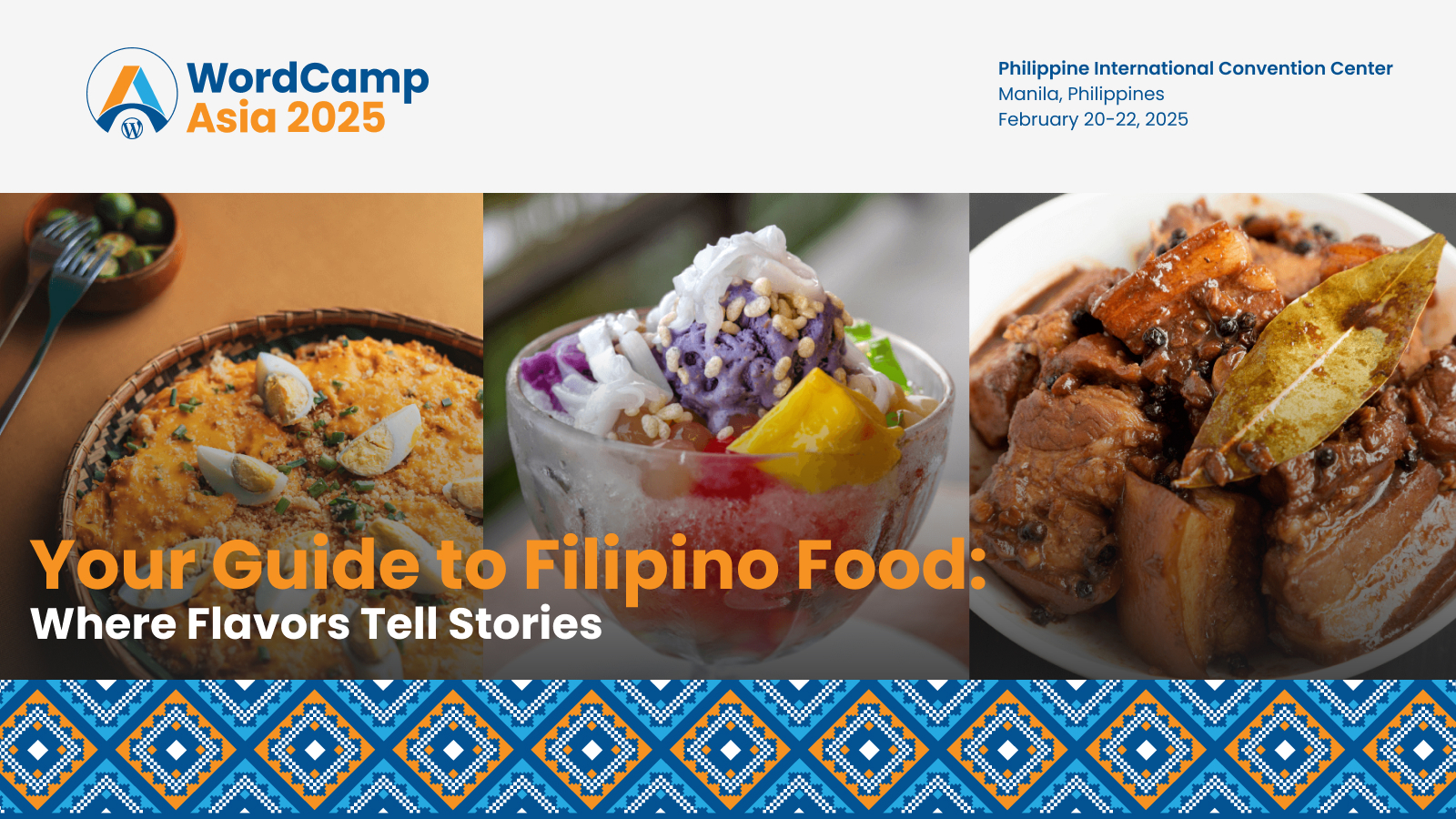Imagine a place where flavors dance between sweet and sour. Where garlic-perfumed rice fills the morning air, and every street corner holds a delicious secret. Welcome to Filipino cuisine, a melting pot of flavors shaped by history.
Born from an archipelago of 7,641 islands, Filipino food is a blend of influences. From Spanish fiestas and Chinese trade routes, to American innovations and Japanese precision, it’s all woven together with native ingenuity. This is honest food, shaped by resourcefulness and foreign ties. It doesn’t try to be fancy, but instead, wraps you in a warm hug of familiar comfort, even if you’re trying for the first time. And like the spirit of bayanihan, where communities come together to help one another, Filipino cuisine itself is a collective effort, a shared history of generations adding their own flavors to the pot.
(And, spoiler alert: WordCamp Asia 2025 is going to be swimming in delicious Filipino food. You can check the lunch menu here.)
But what makes Filipino food, Filipino?
It’s the way a meal isn’t complete without kanin (rice), the heart of every meal. It’s the abundance of ulam (viands), the savory-sour adobo or the tangy sinigang (tamarind broth), each dish a story passed down through generations. It’s the sawsawan (dipping sauces) that add another layer of flavor, with each region having its unique taste. And it’s the way we eat, mixing everything together on one plate, creating a unique blend of textures and tastes in every bite.
Filipino Street Food: Where Every Corner Tells a Story
In the bustling streets of Manila, the heart of all things Filipino, street food brings everything together. From humble metal carts and makeshift grills, the most beloved Filipino flavors come alive. The sizzle of street food tells stories of midnight cravings, student adventures, and the interaction of strangers through cuisine.
Don’t miss out on trying:

- Balut: The famous fertilized duck egg. Yes, it sounds scary, but it’s a beloved midnight snack that tests the brave!
- Kwek-kwek: Golden-battered quail eggs, drowned in sweet-spicy sauce.
- Taho: Hot silky tofu with brown sugar syrup and chewy pearls, a breakfast choice that makes every Filipino’s mornings magical.
Pancit (Noodles): Strands of Heritage
Filipino noodles, or pancit, were born of ancient trade winds from Chinese merchants who made the Philippine islands their home.
Each variety speaks a different dialect of deliciousness:

- Pancit Bihon: A Crown jewel in every Filipino’s birthday celebration, originating from the Chinese traders on the island of Luzon.
- Pancit Malabon: A vibrant yellow, seafood-rich noodle dish from the northern part of Metro Manila.
- La Paz Batchoy: A warm, hearty noodle soup born in the La Paz district of Iloilo city.
Kanin (Rice): The Heart of Every Meal
Rice in Filipino culture is more than sustenance, it’s the soul of every meal. Try it in these staple forms:

- Silog: Is the ultimate Filipino breakfast, and its name comes from combining sinangag (garlic fried rice) and itlog (fried egg). These two are the foundation of every Silog meal, serving as a perfect canvas for the third star ingredient — protein.
Some Filipino favorites include:
- Tapsilog: Tapa (marinated beef strips) + silog
- Longsilog: Longanisa (Filipino sausage) + silog
- Tocilog: Tocino (sweet pork) + silog
- Arroz Caldo: Our comfort in congee form, a hearty Filipino rice porridge served with chicken.
- Adobo Rice: Where yesterday’s adobo becomes today’s fried rice goodness.
Ulam (Viand): Where Traditions Come Alive
These are the Filipino dishes that gather families and turn ordinary days into celebrations:

- Adobo: A masterpiece that transforms humble ingredients: vinegar, soy sauce, garlic, and peppercorns, with either pork or chicken, into the Filipino iconic dish. Where every family has their own cherished recipe.
- Sinigang: The ultimate comfort food, sinigang’s tangy broth, infused with tamarind, awakens the palate. Loaded with vegetables and your choice of meat or seafood it surely is a celebration of Filipino flavors for any occasion.
- Lechon: The pride of Cebu city. The king of Filipino fiesta. This slow-roasted pork boasts crackling skin and tender meat. Stuffed with herbs and aromatics, lechon is a labor of love representing abundance and joy.
Panghimagas (Desserts): Sweet Endings
Filipino desserts tell stories of childhood summers and afternoon snacks:

- Halo-halo: This iconic shaved dessert is a vibrant celebration of all things Filipino. With layers of sweet beans, fruits, jellies, ube ice cream, and more, every spoonful is a surprise to the senses.
- Leche Flan: A silky-smooth Filipino custard with caramel sauce. Its melt-in-your-mouth texture and decadence make it a beloved treat for all ages.
- Ube: A vibrant purple yam that has captured the hearts (and stomachs) of Filipinos. From ice cream to cakes and pastries, its gentle sweetness makes it truly unique and unforgettable.
This is just a glimpse of the many delicious dishes waiting to be discovered! Filipino cuisine is a vast and exciting world of flavors, with each region boasting its own unique specialties!
Experience Filipino Food at WordCamp Asia 2025!
We’re serving you a full Filipino course meal during lunchtime at WordCamp Asia 2025. Use our published lunch menu as your guide to experience the different Filipino flavors. But don’t stop there! We encourage you to explore the streets of Manila, and its convergence of flavors from all over the Philippines. You’ll find delicious food everywhere.
Remember, Filipino food isn’t just about taste, it’s about the story behind every bite, the hands that prepared it, and the hearts it brings together. Welcome to the table, where every meal is a celebration of life, love, and the beautiful complexity of Filipino culture.




